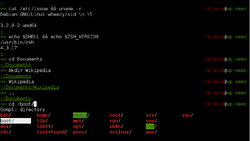Z shell
 Screenshot of a zsh session | |
| Original author(s) | Paul Falstad[1] |
|---|---|
| Developer(s) | Peter Stephenson, et al.[1] |
| Initial release | 1990 |
| Stable release | 5.2
/ December 3, 2015 |
| Repository | |
| Written in | C |
| Operating system | Various |
| Type | Unix shell |
| License | MIT-like[2] |
| Website | www |
The Z shell (zsh) is a Unix shell that can be used as an interactive login shell and as a powerful command interpreter for shell scripting. Zsh is an extended Bourne shell with a large number of improvements, including some features of bash, ksh, and tcsh.
Origin
Paul Falstad wrote the first version of zsh in 1990[3] while a student at Princeton University.[4] The name zsh derives from the name of Yale professor Zhong Shao (then an Assistant Professor at Princeton University) — Paul Falstad regarded Shao's login-id, "zsh", as a good name for a shell.[5][6] Speakers of American English pronounce "Z" as zee, so "Z shell" is allophonous with "C shell", which in turn is a homophone of "seashell".
Features

Features include:
- Programmable command-line completion that can help the user type both options and arguments for most used commands, with out-of-the-box support for several hundred commands
- Sharing of command history among all running shells
- Extended file globbing allows file specification without needing to run an external program such as find
- Improved variable/array handling
- Editing of multi-line commands in a single buffer
- Spelling correction
- Various compatibility modes, e.g. zsh can pretend to be a Bourne shell when run as
/bin/sh - Themeable prompts, including the ability to put prompt information on the right side of the screen and have it auto-hide when typing a long command
- Loadable modules, providing among other things: full TCP and Unix domain socket controls, an FTP client, and extended math functions.
- The built-in
wherecommand. Works like thewhichcommand but shows all locations of the target command in the directories specified in$PATHrather than only the one that will be used. - Named directories. This allows the user to set up shortcuts such as
~mydir, which then behave the way~and~userdo.
A user community website called "Oh My Zsh" collects third-party extensions to the Z shell.[7]
See also
References
- ^ a b "The Z Shell Manual" (Version 5.0.0). Sourceforge.net. July 21, 2012. Retrieved September 18, 2012.
- ^ "zsh / Code / [281031] /LICENCE". Paul Falstad. Retrieved February 7, 2015.
- ^ "zsh - a ksh/tcsh-like shell (part 1 of 8)". alt.sources. December 14, 1990. Retrieved September 18, 2012.
- ^ "Z-Shell Frequently-Asked Questions". Sourceforge.net. February 15, 2010. Retrieved September 18, 2012.
- ^ "The Z-Shell (ZSH) Lovers' Page". Guckes.net. c. 2004. Retrieved October 2, 2012.
- ^ "Zsh Mailing List Archive". Zsh.org. August 8, 2005. Retrieved October 2, 2012.
- ^ "Oh My ZSH - Community driven framework with 150+ plugins and 100+ themes". Retrieved May 7, 2014.
External links
Official
Articles
Other
- zsh at Curlie
- Oh My ZSH!
